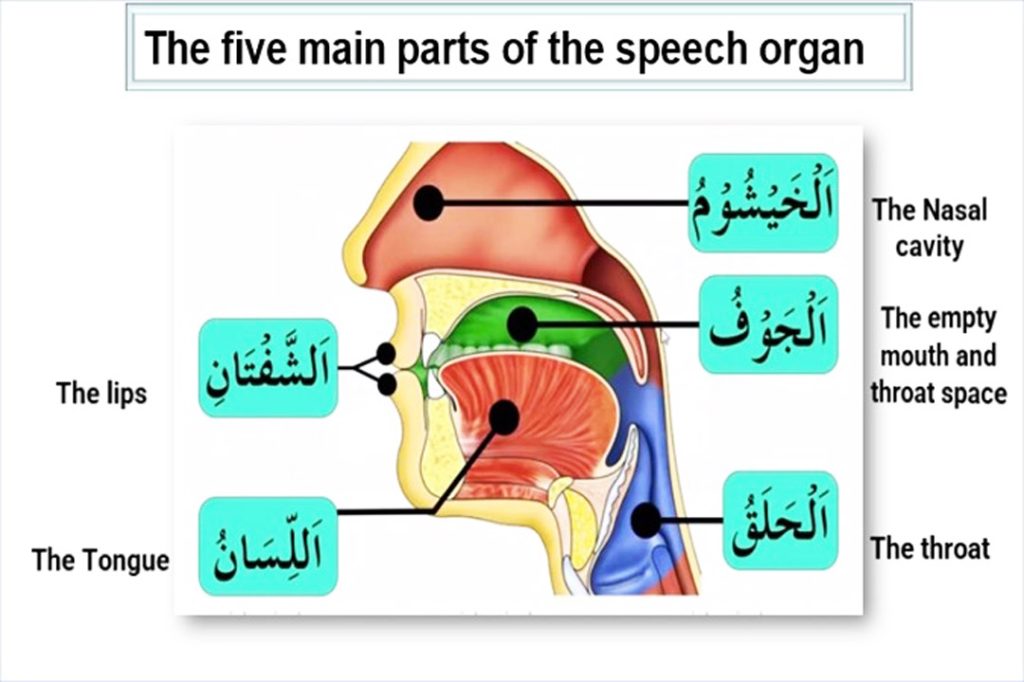In Tajwid, students learn various aspects and rules that contribute to the accurate and beautiful recitation of the Quran. Tajwid encompasses the study of phonetics, pronunciation, articulation, and the application of specific rules to ensure the proper recitation of Arabic letters and words. Here are some key areas covered in the study of Tajwid:
- Arabic Phonetics
Students learn the correct pronunciation of Arabic letters, including their points of articulation, characteristics, and how they are produced using different parts of the mouth, tongue, and throat. This knowledge is essential for accurately reciting the Quran and distinguishing between similar sounds.

- Articulation Points
Tajwid focuses on the precise articulation points of Arabic letters, which include the lips, tongue, the throat, and the nasal and oral cavity. Understanding and mastering these articulation points enables students to produce clear and distinct sounds while reciting the Quran. For example, the lips are the Makharij of the letters Mim “م” (M) and Baa “ب” (B). It means when we pronounce these letters, we engage the usage of the lips, and the sound relies on the lips.
There are a total of 17 points of articulation, according to many of the scholars, including Ibn Al Jazari.
Five major areas of the vocal tract are used to pronounce different letters. There are 17 places of articulation to pronounce the 28 consonant letters and the Huroof al- Maddi (ا و ی).
These 17 makhârij are grouped into five main places of phonation:
1.The Oral Cavity (Al-Jawf) – One point of articulation
2.Throat (Al-Halq) – Three points of articulation
3.Tongue (Al-Lisaan) – Ten points of articulation
4.Lips (Al-Shafatain) – Two points of articulation
5.Nasal Cavity (Al-Khaishoom) – One point of articulation

- Characteristics of Letters
Each Arabic letter has unique characteristics that affect its pronunciation. Tajwid teaches students to recognize and apply these characteristics, such as the elongation (madd) of vowels, the heavy (tafkhim) or light (tarqiq) pronunciation of certain letters, and the merging (idgham) or distinct pronunciation (ikhfa) of specific combinations of letters.
The characteristics of the letters play a crucial role in differentiating one letter from another, even if it shares the same articulation point. We see that several letters could leave the same exit point. These characteristics allow us to distinguish between letters when they are pronounced. For example, some letters sound soft, some sound hard, some need breathing and some do not, etc.
If the student of the Qur’an fails to apply all the characteristics of the letter that they are articulating, it can result in the letter sounding completely different or, at the very least, incorrect.
Therefore, it is evident that studying the characteristics of the letters and their application is a crucial part of Tajwid. The proper application of the characteristics of letters distinguishes a good reciter from an average one. - Rules of Tajwid
Students learn a set of rules that govern the correct recitation of the Quran. This aspect of Tajwid focuses on explaining the rules and changes which occur to the pronunciation of the letters when they are combined with others. These rules encompass various areas such as elongation (madd), pausing (waqf), stopping (hafs), merging (idgham), distinct pronunciation (ikhfa), nasalization (ghunnah), and other rules that ensure the proper flow and melody of recitation. Understanding and applying these rules contribute to the beauty and accuracy of the recitation. For example, when the letter Noon “ن” (N) is followed by the letter Baa “ب” (B), it should be pronounced as “م” (M).
In order to recite and read Quran correctly, one needs to know Makharij, Sifaat and the Ahkam of the letters.
By studying Tajwid, students acquire the necessary knowledge and skills to recite the Quran accurately, beautifully, and with proper understanding. Tajwid serves as a means to preserve the integrity of the Quran’s recitation and also provides a pathway to connect with its divine message and experience its transformative power.
If you are interested in learning Tajwid and don’t have enough time to attend a class, don’t worry! DarulQuran academy has solved this problem by holding online Tajwid classes at various levels, taught by the best teachers. In DarulQuran, you have the flexibility to choose a class time according to your convenience.
For more information, visit the website of DarulQuran academy:
https://darulquran.co.uk/courses/tajweed-in-quran-recitation/

















